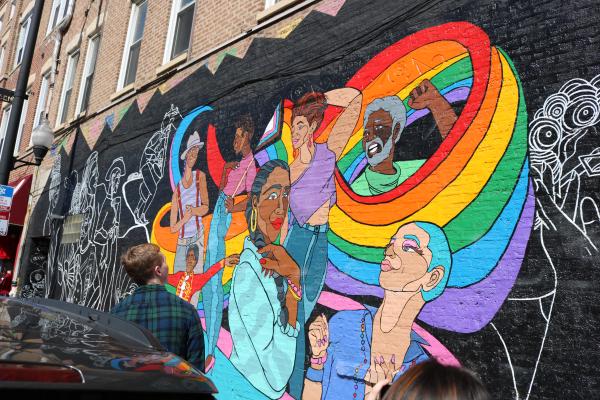Fierce
artists
Samantha Kirk
location
1608 W 18th Street
Themes: LGBTQ+, culture, global issues
This mural, entitled Fierce by Sam Kirk and sponsored by EFFEN Vodka, celebrates the presence of the queer community across cultures internationally. This piece was created in June 2021, one block from the place Kirk was beaten unconscious for holding her girlfriend’s hand when she was younger. Not only is the piece a statement of the social progress Pilsen has made over the years, but it connects the city of Chicago as a whole to global discussions about queerness.
The mural consists of a group of queer individuals waving around the progress pride flag at the center of an otherwise black wall with white outlined figures. The background figures in people proudly wearing iconography related to different cultures. There are, of course, traditionally Mexican symbols such as a man on the left wearing the image of The Virgin Guadalupe or the large-scale woman on the right wearing a mariachi suit with skulls on the forearms. In using this iconography, Kirk ties Pilsen’s historically predominant Mexican culture to her depictions of queerness, but does not center it. Instead people of other cultures are intertwined with such characters. Similarly, there are allusions to Chicago in the CTA train and bus stop and in the traditional Chicago townhouses at center right. Even still, this piece does not emphasize its ties to Chicago or one specific social group, but rather promotes solidarity across global cultures. Further supporting this point, the individuals in the middle, depicted in highly vibrant colors, are all of different races and genders. While there is no significance given to one group over another, a Black woman is centered in the composition. This is of importance because all too often, Black and queer activists have been discredited for their work in the LGBTQ community. Having said this, the subjects in the piece, both in black-and-white and in color, coexist harmoniously. Through its vibrancy and flowing lines, Fierce reads as a celebration for this community.
The figures in the piece stand out from other murals in Pilsen because of their ties to gender and sexuality. For example, returning to the woman in the mariachi suit, although the same suit may be depicted on other walls in Pilsen, seldom is a woman wearing it. Kirk connects the ideas of cultural identity (in the suit) with ideas of gender related to clothing. Similarly, there is a man with a headcovering wearing high heels, another fashion choice that would face discrimination in traditional conversations of gender presentation. In evoking both of these images, Kirk expands her ideas of cultural identity and queerness to communties beyond historically Mexican Pilsen.
In terms of color selection, the black-and-white portion of the wall could illustrate this community has marginalized and pushed into secrecy in society. In another interpretation, the binary nature of such colors could evoke the conservative devotion to the gender binary and the oversimplification of sexuality that is heteronormativity. In either case, Kirk brings individuals that had been overshadowed and discriminated against to the focal point of the artwork in full, explosive color. Their bright presence and celebration of their true selves provides a counternarrative to such ideas.
Overall, in Fierce, Kirk explores the intersectionality of cultural identity and queerness. Kirk encourages individuals to express their gender and sexuality in spaces that align with their cultural identity. She exemplifies how the world can be beautiful wherein these identities are allowed to coexist, both in Pilsen and throughout the world.
This description was written by Notre Dame student Myldred Hernandez-Gonzalez, Class of 2024.

